|
|
 |
|
Calanoida ( Order ) |
|
|
|
Diaptomoidea ( Superfamily ) |
|
|
|
Pontellidae ( Family ) |
|
|
|
Calanopia ( Genus ) |
|
|
| |
Calanopia minor A. Scott, 1902 (F,M) | |
| | | | | | | Ref.: | | | A. Scott, 1902 (p.406, figs.F,M); Thompson & Scott, 1903 (p.235, 251); A. Scott, 1909 (p.177, figs.F,M); Pesta, 1912 a (p.51, figs.M); Sewell, 1914 a (p.232); 1932 (p.342); Bowman, 1957 (p.39, Rem.); Brodsky, 1962 c (p.146, figs.F); Kasturirangan, 1963 (p.48, figs.F,M); Tanaka, 1964 c (p.251, figs.F,M); Chen & Zhang, 1965 (p.96, figs.F,M); Kos, 1972 (Vol. I, figs.F, M, Rem.); Silas & Pillai, 1976 (p.782, Rem., figs.F,M); Marques, 1976 (p.997, fig.F); 1982 (p.766); Zheng & al., 1982 (p.71, figs.F,M); Chihara & Murano, 1997 (p.865, Pl.146: F,M); Bradford-Grieve & al., 1999 (p.885, 958, figs.F,M); Mulyadi, 2002 (p.44, figs.F,M, Rem.); Conway & al., 2003 (p.122, figs.F,M, Rem.); Phukham, 2008 (p.75, figs.F); Al-Yamani & al., 2011 (p.60, figs.F,M)
| 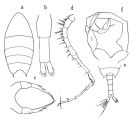 issued from : O. Tanaka in Publs Seto Mar. Biol. Lab., 1964, XII (3). [p.251, Fig.230]. Female (from Izu region, Japan): a, cephalothorax (dorsal); b, urosome (dorsal); c, P5. Nota: Cephalothorax 0.84 mm; abdomen 0.43 mm. Head and 1st thoracic segment separate Last thoracic segment produced posteriorly on each side into an acute spine. Rostrum pointed. Abdomen 2-segmented. The segments and caudal rami in the proportional lengths as 37 : 44 : 19 = 100. Caudal rami about 2.2 times as long as wide.A1 17-segmented, extends to the end of the cephalothorax. P5 3-segmented; the distal segment has a long inner seta. Male: d, right A1; e, last thoracic segment and urosome (dorsal); f, P5. Abdominal segments and caudal rami in the proportional lengths 17 : 19 : 19 : 15 : 11 : 19 = 100. The left A1 extends to the end of the 3rd thoracic segment; the right A1 is modified into a grasping organ and has moderately stout denticles on the 18th segment; the 20th and 21st segments separated. Caudal rami 3 times as long as wide. Remaks: One adult female in vertical hauls from 200-0 m and a male from 500-0 m.
|
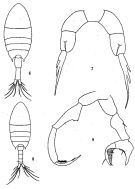 issued from: Q.-c. Chen & S.-z. Zhang in Studia Marina Sinica, 1965, 7. [Pl.39, 6-9]. Female (from E China Sea): 6, habitus (dorsal); 7, P5 (posterior). Male: 8, habitus (dorsal); 9, P5 (posterior).
|
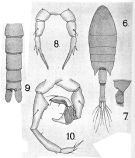 issued from : A. Scott in Siboga-Expedition, 1909, XIX a. [Plate XLVIII, Figs.6-10]. Female (from Indonesia-Malaysia): 6, habitus (dorsal); 7, last thoracic and genital segment (left side); 8, P5. 9, urosome; 10, P5.
|
 issued from : E.G. Silas & P.P. Pillai in J. mar. biol. Ass. India, 1973 (1976), 15 (2). [p.783, Fig.1]. Female (from Indian Ocean): a, urosome (dorsal); b, rostrum; c, P5. Male: d, right A1 (geniculate); e, P5. Scale: single bar denotes 0.3 mm and double bars 0.05 mm.
|
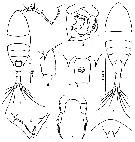 issued from : Z. Zheng, S. Li, S.J. Li & B. Chen in Marine planktonic copepods in Chinese waters. Shanghai Sc. Techn. Press, 1982 [p.71, Fig.41]. Female: a, habitus (dorsal); b, rostrum (frontal view); c, genital segment (ventral); d, idem (lateral, left side); e, P5. Male: f, habitus (dorsal); g, grasping segments of right A1; h, P5. Scale bars in mm.
|
 issued from : Mulyadi in Treubia, 2002, 32; [p.45, Fig.12]. Female (from Indonesian waters): a, habitus (dorsal); b, P3; c, P4; d, P5. Male: e, habitus (dorsal); f, P5.
|
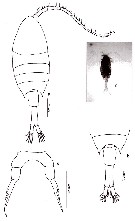 issued from : N. Phukham in Species diversity of calanoid copepods in Thai waters, Andaman Sea (Master of Science, Univ. Bangkok). 2008. [p.157, Fig.31]. Female (from W Malay Peninsula): a, habitus (dorsal); b, urosome (dorsal); c, P5. Body length after the drawing: F = 1.283 mm.
|
 Issued from : J.M. Bradford-Grieve, E.L. Markhaseva, C.E.F. Rocha & B. Abiahy in South Atlantic Zooplankton, edit. D. Boltovskoy. 1999, Vol. 2, Copepoda; [p.1067, Fig. 7.380: Calanopia minor]. r = right leg; l = left leg; B = basis; Exp1 = exopodal segment 1; Exp2-3 : exopodal segment 2-3; Exp3 = exopopdal segment 3. Female characters (from key, p.958): - P5 with 1 segment distal to basis. - P5 terminal segment bifurcate distally, inner spine long and spinulose. Male characters (from key, p.958): - Distinct 'thumb' present on right P5 exopodal segment1-2. - distal border of right P5 basis not extend much beyond middle of left basis.
|
 Calanopia minor Calanopia minor. Female :
1 – P5 exopod 1-segmentef
2 – Exopodal segment of P5 with 3 spines
3 – Exopodal segment of P5 with 2 small lateral spines and 1 long medial spine (longer than segment itself)
Male :
1 – Left P5 longer than right one ; basis of left P5 swollen proximally. 2 – 2nd exopodal segment of right P5 nearly 2/5 length of 1st exopodal segment; coxa of right P5 about or less than 1.4 times as long as basis. 3 – Basis of left P5 swollen proximally and produced into a small curved tooth.
|
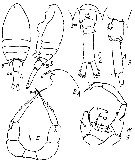 Issued from : M.C. Kos in Field guide for plankton. Zool Institute USSR Acad., Vol. I, 1972. Female: A, habitus (dorsal), after A. Scott, 1909); After Brodsky, 1962: Female: 1, forehead and rostrum (lateral); 2-3, corner of the last thoracic segment and abdomen (ventral and lateral, respectively); 4, P5. Male: 5,3 habitus (lateral); 6, P5.
|
 Issued from : R. Gurney in Trans. zool. Soc. London, 1927, 22. [p.154]. Relative lengths of cephalothorax, abdomen and caudal rami; and the genital double-somite and the 2nd abdominal somite. Comparison between Calanopia media, C. elliptica and C. minor females.
| | | | | Compl. Ref.: | | | Cleve, 1904 (p.177); Sewell, 1912 (p.353, 368); Gurney, 1927 (p.154, Rem.); Sewell, 1948 (p.419, 434); C.B. Wilson, 1950 (p.175, non st. atlantique); Chiba & al., 1957 (p.308); Ganapati & Shanthakumari, 1962 (p.9, 15); De Decker, 1964 (p.14, 17, 27); De Decker & Mombeck, 1964 (p.11); Delalo, 1968 (p.138); Patel, 1975 (p.660); Carter, 1977 (1978) (p.36); Sreekumaran Nair & al., 1981 (p.493), Guangshan & Honglin, 1984 (p.118, tab.); De Decker, 1984 (p.317, 330: chart); Binet, 1984 (tab.3); 1985 (p.85, tab.3); M. Lefèvre, 1986 (p.33, 40, 92); Madhupratap & Haridas, 1986 (p.105, tab.1); 1990 (p.305, fig.4: vertical distribution night/day; fig.7: cluster); Echelman & Fishelson, 1990 a (tab.2); Madhupratap & al., 1991 (p.947, Rem.: p.951); Shih & Young, 1995 (p.71); Padmavati & Goswami, 1996 a (p.85, fig.2, 3, Table 4, vertical distribution); Padmavati & al., 1998 (p.347); Wong & al, 1998 (tab.2); Mauchline, 1998 (tab.8); Lo & al., 2001 (1139, tab.I); Uysal & al., 2002 (p.17, tab.1); Osore & al., 2003 (p.69); Hwang & al., 2003 (p.193, tab.2); Shimode & Shirayama, 2004 (p.607,tab.2); Hsiao & al., 2004 (p.326, tab.1); eazai & al., 2004 (p.489, tab.2); Lo & al.*, 2004 (p.218, fig.6); Lo & al., 2004 (p.468, tab.2); Lan & al., 2004 (p.332, tab.1); Lo & al., 2004 (p.89, tab.1); Kazmi, 2004 (p.228); Rezai & al., 2005 (p.157, Table 5: spatial & temporal variations); Zenetos & al., 2005 (p.63, Rem.: p.82, casual occurrence); Rakhesh & al., 2006 (p.93, Table 2, spatial distribution); Hwang & al., 2006 (p.943, tabl. I); Hwang & al., 2007 (p.24); Dur & al., 2007 (p.197, Table IV); Jitlang & al., 2008 (p.65, Table 1); Tseng L.-C. & al., 2008 (p.153, Table 2, fig.5, occurrence vs geographic distribution, indicator species); Tseng & al., 2008 (p.402, Table 2); Lan Y.-C. & al., 2008 (p.61, Table 1, % vs stations, Table 2: indicator species); C.-Y. Lee & al., 2009 (p.151, Tab.2); Lan Y.-C. & al., 2009 (p.1, Table 2, % vs hydrogaphic conditions); Cornils & al., 2010 (p.2076, Table 3, Fig.5); Zenetos & al., 2010 (p.397); W.-B. Chang & al., 2010 (p.735, Table 2, abundance); Shanthi & Ramanibai, 2011 (p.132, Table 1); Hsiao S.H. & al., 2011 (p.475, Appendix I); Hsiao & al., 2011 (p.317, Table 2, indicator of seasonal change); Kâ & Hwang, 2011 (p.155, Table 3: occurrence %); Tseng L.-C. & al., 2011 (p.47, Table 2, occurrences vs mesh sizes); Maiphae & Sa-ardrit, 2011 (p.641, Table 2, 3, Rem.); Pillai H.U.K. & al., 2011 (p.239, Table 3, vertical distribution); Pagano & al., 2012 (p.538, Table 1); Tseng & al., 2012 (p.621, Table 3: abundance, indicator species); Jose & al., 2012 (p.20, fig.3 a,b,c: % vs monsoon); Tseng & al., 2013 (p.507, seasonal abundance); Jagadeesan & al., 2013 (p.27, Table 3, 4, 5, 6, fig.11, seasonal abundance); Anjusha & al., 2013 (p.40, Table 3, abundance & feeding behavior); Hwang & al., 2014 (p.43, Appendix A: seasonal abundance); Beltran Castro, 2014 (p.34, Table 1); Nakajima & al., 2015 (p.19, Table 3: abundance); Jerez-Guerrero & al., 2017 (p.1046, Table 1: temporal occurrence) | | | | NZ: | 11 | | |
|
Distribution map of Calanopia minor by geographical zones
|
| | | | | | | | | | | |  Issued from : M. Madhupratap & P. Haridas in J. Plankton Res., 12 (2). [p.311, Fig.4]. Issued from : M. Madhupratap & P. Haridas in J. Plankton Res., 12 (2). [p.311, Fig.4].
Vertical distribution of calanoid copepod (mean +1 SE), abundance No/100 m3. 32- Calanopia minor.
Night: shaded, day: unshaded.
Samples collected from 6 stations located off Cochin (India), SE Arabian Sea, November 1983, with a Multiple Closing Plankton Net (mesh aperture 300 µm), in vertical hauls at 4 depth intervalls (0-200, 200-400, 400-600, 600-1000 m). |
| | | | Loc: | | | South Africa (E & SW), [G. of Mexico (in C.B. Wilson, 1950)], E Medit. (NW Lebanon Basin), ? Suez Canal (after Scott), G. of Aqaba, Red Sea, Arabian Sea, Arabian Gulf, Laccadives Is. (lagoons), Natal, Madagascar (Nosy Bé), Seychelles, Indian, India ( Goa-Gujarat, Mangalore coast, G. of Mannar, Palk Bay, Saurashtra coast, Lawson's Bay), E India (coastal); Bay of Bengal, Andaman Sea (Barren Island), W Malay Peninsula (Andaman Sea), Straits of Malacca, G. of Thailand, Indonesia (Sunda Strait, Cilacap Bay, NE Java coast, Ambon Is., Tioman Is., SW Celebes), Philippines, Viet-Nam (Cauda Bay), China Seas (East China Sea, South China Sea), Taiwan Strait, Taiwan (S, E, SW, W, Tapong Bay, NW, N, NE, Mienhua Canyon), S Korea, Japan (Tanabe bay), W Pacif. (equatorial), New Caledonia, Tuamotu Is., Ahe atoll lagoon, Moorea Is. (lagoon), Hawaii, Bahia Cupica (Colombia), Galapagos, G. of California, Islas Marias
Type locality: Red Sea. | | | | N: | 99 | | | | Lg.: | | | (5) F: 1,4; M: 1,2; (120) F: 1,27; M: 1,23; (334) F: 1,4; M: 1,2; (256) F: 1,4-1,24; M: 1,18-1,11; (290) F: 1,15-1,4; M: 1,1-1,15; (332) F: 1,4-1,31; (333) F: 1,4-1,14; M: 1,06; (991) F: 1,24-1,4; M: 1,11-1,18; (1023) F: 1,3; M: 1,13; (1087) F: 1,24-1,3; M: 1,1-1,18; (1085) F: 1,2-1,4; M: 1,1-1,2; (1230) F: 1,2-1,5; M: 1,2; {F: 1,14-1,50; M: 1,06-1,23} | | | | Rem.: | Neritic.
After Mulyadi (2002, p.46) this species resembles C. aurivilli and C. americana.
The locality record given by C.B. Wilson (1950) in the Atlanic Ocean is considered very doubtful.
Uysal & al. (2002) report the presence of this species for the first time in the Eastern Mediterranean Sea (possible Lessepsian migration).
See in DVP Conway & al., 2003 (version 1) | | | Last update : 20/06/2020 | |
|
|
 Any use of this site for a publication will be mentioned with the following reference : Any use of this site for a publication will be mentioned with the following reference :
Razouls C., Desreumaux N., Kouwenberg J. and de Bovée F., 2005-2025. - Biodiversity of Marine Planktonic Copepods (morphology, geographical distribution and biological data). Sorbonne University, CNRS. Available at http://copepodes.obs-banyuls.fr/en [Accessed December 24, 2025] © copyright 2005-2025 Sorbonne University, CNRS
|
|
 |
 |












